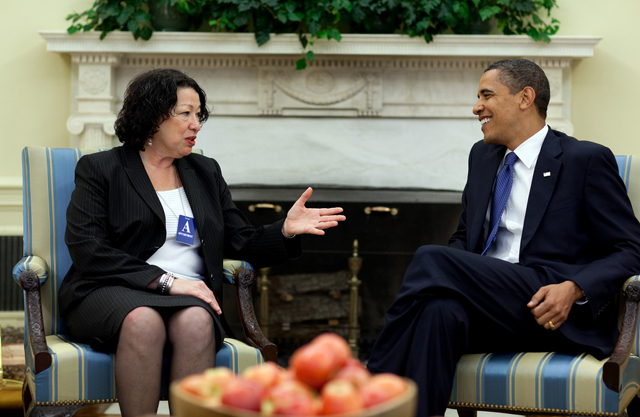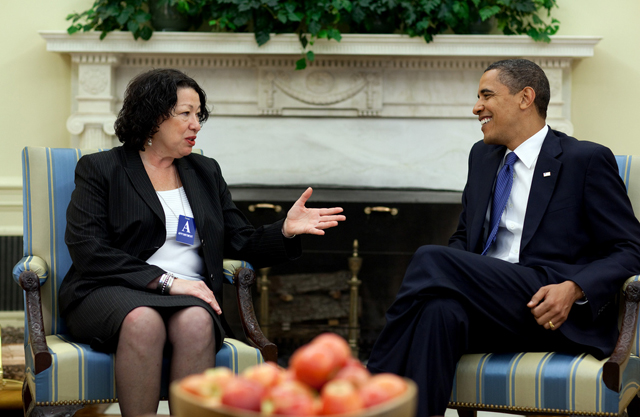
President Obama today selected Sonia Sotomayor as his first nominee to the U.S. Supreme Court. If confirmed, she would become the first Latin American and only the third woman to sit on the highest court in the land.
The hot topic of conversation surrounding her nomination is affirmative action, but over in Gristland, we’re wondering, just how green is she?
Sotomayor’s limited record on environmental cases is pretty promising, indicating that she will likely follow in the footsteps of the justice she would replace, David Souter, who was a reliable green vote.
“This is the best Supreme Court nomination in many years,” EarthJustice President Tripp Van Noppen gushed to Grist. “She’s got more judicial experience than any nominee in 70 years, more federal judicial experience than any nominee in 100 years … She’s very strong in terms of experience.”
He acknowledged that she doesn’t have many major environmental decisions to her name, but said that her record indicates she will be faithful to the rule of environmental law.
“She’s ruled both ways on environmental cases, so it’s not like she’s ideologically committed one way or another, and that’s not what we look for in a judge,” said Van Noppen. “We look for a willingness to be fair in applying the law.”
The most significant environmental case in Sotomayor’s record is her ruling in 2007’s Riverkeeper, Inc. v. EPA. The case centered on whether or not the Environmental Protection Agency should be allowed to consider the cost-effectiveness of measures to protect fish and other aquatic life forms in rivers and lakes near power plants.
Sotomayor argued in her decision that the EPA should not use cost-benefit analysis to determine what technologies to use for cooling-water intake structures at power plants. The Clean Water Act says that these intake structures must use the “best technology available” to prevent harm to aquatic life (i.e., fish getting stuck on machinery, or smaller fish getting sucked right up into the system), but it doesn’t specify what would qualify as such. Sotomayor argued that the determination should be based on the environmental benefit, honoring the original intent of the Clean Water Act:
“… assuming the EPA has determined that power plants governed by the Phase II Rule can reasonably bear the price of technology that saves between 100-105 fish, the EPA, given a choice between a technology that costs $100 to save 99-101 fish and one that costs $150 to save 100-103 fish (with all other considerations, like energy production or efficiency, being equal), could appropriately choose the cheaper technology on cost-effectiveness grounds.
The Agency is therefore precluded from undertaking such cost-benefit analysis because the [best technology available] standard represents Congress’s conclusion that the costs imposed on industry in adopting the best cooling water intake structure technology available (i.e., the best-performing technology that can be reasonably borne by the industry) are worth the benefits in reducing adverse environmental impacts.
In April, the Supreme Court overturned her decision in a 6-3 ruling in favor of the power companies – a major disappointment for enviros.
“[Sotomayor] took the line that we and most environmental groups would agree with, which I think is the proper construction of the statute,” said Jay Austin, a senior attorney at the Environmental Law Institute. “This clearly shows that she understands these issues.”
But Van Noppen also pointed to a 2004 case in the Second Circuit, Environmental Defense v. the United States Environmental Protection Agency, in which she sided against environmentalists who challenged the EPA’s acceptance of a New York state plan to meet national air quality standards for ozone. She didn’t author the decision, but agreed with the majority in deciding for the EPA.
Still, Van Noppen said her record indicates both that she acknowledges the rights of citizens to challenge regulatory authorities if they fail to uphold their legal mandate, and that she affirms the authority of environmental regulatory agencies. This perspective differs markedly from the one shared by the Supreme Court’s four conservative justices – Antonin Scalia, Clarence Thomas, John Roberts, and Samuel Alito – who have repeatedly challenged both these premises.
“She’s likely to honor citizens’ rights to use the courts to enforce the law, because that’s the way those laws are written, and to use the authority of those agencies to carry out their mission as it has been created by Congress,” said Van Noppen.
Court is in order
If Sotomayor is confirmed, it won’t shift the court on this and similar issues. Though Souter was appointed by Republican George H.W. Bush, he tended to side with the more liberal members of the court — he was among the justices who sided with Sotomayor’s original decision in the Riverkeeper case.
“I’m not sure any Obama appointee was going to be in the position to shift the court at this point, given that you’re talking about replacing Souter’s vote, and he was pretty good on all of our issues,” said Austin.
Sotomayor was also a Bush appointee, named to the District Court for the Southern District of New York by President George H.W. Bush in 1991 and promoted to the Second Circuit by President Bill Clinton in 1997. Environmentalists are optimistic she’ll follow Souter’s example, voting for the most part with liberal justices Ruth Bader Ginsburg, John Paul Stevens, and Stephen Breyer. (The only justice counted as a swing vote on environmental issues is Anthony Kennedy.) In the next few years, new lawmaking on climate change is expected and several key climate cases could reach the high court. It was the Supreme Court which, in 2007, determined that the EPA has the authority to regulate carbon dioxide under the Clean Air Act if it determines that carbon dioxide is a threat to public welfare. The EPA concluded last month that it is in fact a threat, triggering the beginning of regulation of these planet-warming gases.
“The climate change decision two years was a landmark case,” said Van Noppen. “Until that ruling came from the Supreme Court, there was a major obstacle in front of the EPA on moving forward on climate change … Once that obstacle was removed, it gave a more sympathetic administration the ability to do some things, so that’s a way that a Supreme Court decision could have a big affect.”
It’s quite likely that the Supreme Court will be again be tasked with determining some of the tough questions about just what is within the EPA’s regulatory authority when it comes to climate change. Any regulations coming from the agency will inevitably meet challenge from industry, environmentalists, or both. And if Congress moves to write new law dealing with climate change more specifically by capping and putting a price on carbon dioxide, the new law will also meet a host of legal challenges which could eventually funnel up to the highest court in the land.
Meanwhile, there are also a number of suits in district courts challenging the legality of the various regional programs to regulate greenhouse-gas emissions that could become more pertinent if Congress doesn’t write a new law this year. Industries that operate in multiple states have balked at the fact that they exist within different regulatory frameworks right now, and have raised the issue of whether this violates interstate commerce laws.
Other major issues that could come before the Court in the next few years include revisiting exactly what bodies of water are covered under the Clean Water Act, which has been a subject of debate for years because the original language in the legislation is not entirely clear. Whether or not wetlands and rivers and streams that exist only during certain seasons should be covered by the law needs to be decided, whether by new legislative language or a Court ruling.
The Endangered Species Act is another major environmental law almost constantly under litigation in district courts, and key decisions could funnel up to the Supreme Court in the near future. One area that could be ripe for a Supreme Court evaluation is the question of what existing laws can do to protect species threatened by climate change, an issue that environmentalists have raised repeatedly when it comes to the polar bear. The Center for Biological Diversity has filed suit in federal court against six agencies of the federal government on the basis that they have not addressed the impacts of warming on endangered species.
“Ultimately, the Supreme Court will probably have to decide how narrowly or broadly the courts are going to look at climate change policy,” said Austin. By all indications, Sotomayor will side with the liberal justices on the issue.


